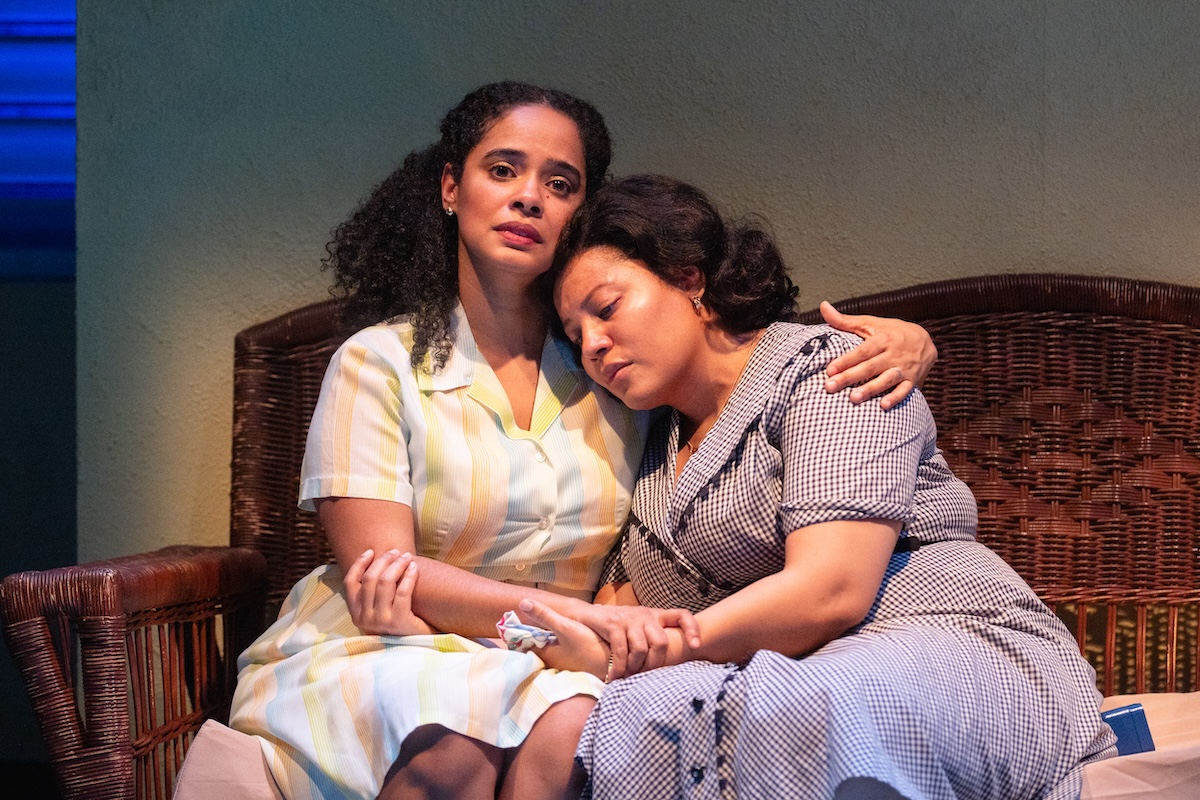Come Back to Jamaica

What will we see at the York this weekend — Jamaica, Pigeon Island, or something in-between?
Of course, Jamaica is what’s advertised for Musicals in Mufti, albeit a new version of the 1957 hit that had music by Harold Arlen, lyrics by E.Y. “Yip” Harburg, and a book by Harburg and Fred Saidy. The three had first collaborated on the big 1944 hit Bloomer Girl, which ran 654 performances and closed as the fifth-longest-ever-running book musical up to that time. Previously, Arlen and Harburg had contributed to three revues — Earl Carroll’s Vanities (1930), Life Begins at 8:40 (1934), and Hooray for What? (1937) — not to mention that Wizard of Oz movie of 1939. After Bloomer Girl, Harburg and Saidy literally and figuratively struck gold with Finian’s Rainbow (1947); but they didn’t do nearly as well with Flahooley (1951), which ran five weeks as compared to Finian’s Rainbow‘s 90. Arlen followed up with highly respected music for two shows that nevertheless flopped, St. Louis Woman (1946) and House of Flowers (1954).
But according to Harold Myerson and Ernie Harburg (Yip’s son), who co-authored the Harburg biography Who Put the Rainbow in The Wizard of Oz?, the Jamaica collaborators originally set out to write a show called Pigeon Island. It dealt with Koli, a young man who’s happy with his life as a fisherman, although his young girlfriend Savannah yearns for the bright lights of the big city (meaning New York). There, she hopes, Koli will be able to make something of himself in another field, for fish is by no means Savannah’s favorite perfume. Koli’s less happy when Joe Nashua arrives from Harlem; he wants pearls, and he offers the local fishermen money to dive and get them for him. All agree but Koli, partly because of his own rugged individualism but more because he knows that Joe’s Manhattan pedigree could very well win Savannah’s heart. Soon, Pigeon Island becomes pearl happy and everyone’s thrilled at the prospect of making a buck. That’s when the atomic bomb drops to end Act I. (And you thought Rose singing “Everything’s Comin’ Up Roses” was a dynamic first-act curtain!) In Act II, everyone is suddenly more interested in fish that’ll keep them alive than pearls that would look good with a basic black Chanel dress. It eventually turns out that it wasn’t an a-bomb at all but a tropical storm that hit the island; still, the point is that everyone has learned a lesson about what’s really important in life.
The authors wanted Harry Belafonte for Koli and Lena Horne for Savannah. Belafonte fell ill and couldn’t do the show, but Horne could, as she told the nation during an appearance on The Ed Sullivan Show. She was then in the midst of a phenomenally successful supper club engagement at the Waldorf-Astoria — such an event that RCA Victor not only recorded the show but released the LP as part of its original cast album line at $4.98, rather than issuing it as a “regular” pop disc at $3.98. The album sold so well that RCA Victor wanted a piece of Pigeon Island.
What they got instead was the recording rights to Jamaica, as the newly refurbished show was called under the aegis of David Merrick, known today as one of the greatest producers of Broadway’s golden age but then merely an upstart who’d made a success of his first musical (Fanny) and was taking on his second with Jamaica. The bookwriters thought that they merely had to give Horne the songs previously assigned to Belafonte and all would be well. However, after the cast of 45 — including Belafonte sub Ricardo Montalban plus Josephine Premice, Ossie Davis, and dancer Alvin Ailey — played the show in Philly and Boston but not Baltimo’, it was clear that much work needed to be done. The reviews weren’t good in either city, yet this didn’t keep people from buying so many tickets that Jamaica opened with a record advance of well over a million dollars. (Some say it was close to two million.) In those days, each orchestra seat only cost $8.35, so this means that quite a few tickets had been sold!
Harburg and Saidy, setting the tone for many creators who would come after them, did not get along with Merrick. When the producer brought in Joseph Stein to doctor the script, Harburg was especially livid and refused to attend the opening, but the critics did show for the show. According to Steve Suskin’s Opening Night on Broadway, three critics raved, one approved, two had mixed feelings, and one wasn’t much pleased. The positive remarks included “Professional work in every department” (Atkinson, Times); “good numbers with bright lyrics, but with a sameness to their form and beat” (Chapman, Daily News); “A tempestuous musical” (Coleman, Mirror); “a grand and glittering goof” (Aston, World-Telegram & Sun); and “What difference does it make that Jamaica has an especially feeble book? The exotic new musical play has the stunning beauty and thrilling voice of Lena Horne” (Watts, Post). But Walter Kerr of the Herald-Tribune noted the lackluster book by asking, “Can you make a whole show out of sheet music?” (Today, the people behind Smokey Joe’s Cafe and Mamma Mia! would say “yes,” while those backing All Shook Up and Good Vibrations can’t be so sure.) “Jamaica,” Kerr wrote, “is the kind of musical that leads you to wonder whether it was produced simply because all concerned had such high, happy hopes for the original cast album.”
RCA Victor released that album in December 1957 and kept it in print until September 1961. Then, in May 1965, when the company decided to re-release 10 of its cut-out cast albums, it chose Jamaica as one of them. Back in 1957, stereo was still new — New Girl in Town was RCA’s first stereo cast album, Jamaica would be the second — and the technology of the time dictated that the record grooves had to be wider in order to accommodate stereophonic sound. As a result, the monaural version of the Jamaica album contained four numbers not heard on the first stereo release. “What Good Does It Do” was one of them, and while it weighed in at 1:45 on the original mono, it was expanded to 2:20 for the 1965 reissue. (By then, stereo grooves didn’t take up as much of the disc.) Not until 1965 did the overture finally show up. To make matters even stranger, Horne had recorded one cut — “Coconut Sweet” — 10 weeks before the rest of the album was done, and this is apparent from even the most casual listen.
It’s not a distinguished score, to be sure. One song, “Ain’t It the Truth,” was written for the 1943 movie version of Cabin in the Sky but dropped from the film. Another, “Napoleon” — about how names that once meant greatness have now devolved to mean something insignificant (“Napoleon’s a pastry…Columbus is a circle”) — was an idea that Harburg and Arlen originally had for Hooray for What?, although they then wrote a different melody and lyrics. But see if you don’t chuckle while listening to the rest. “Push De Button,” which deals with our automated society, says, “What an isle, where an automat feeds ev’ry chile.” “Yankee Dollar” states, “Small boat give salute; de tourist arrive in grey flannel suit.” There’s a good deal of wordplay in “Little Biscuit,” which admits that it contains “crazy rhymin’.” While I applaud the Premice-Davis rendition on the cast album, I prefer Arlen’s own recording on Harold Arlen…and Friend (meaning Barbra Streisand), a Columbia album of the early ’60s. Arlen had a curious and unique voice that was reedy yet intoxicating, and he serves the ditty quite well.
What we’ll see at the York will certainly be a revisal, for Jeff Hochhauser — who’s responsible for one of my favorite underrated musicals, Theda Bara and the Frontier Rabbi — has supplied a new book for the show. See you this weekend, when we’ll learn whether or not this talented writer has made Jamaica better than it was.
********************
[To contact Peter Filichia directly, e-mail him at pfilichia@theatermania.com]










